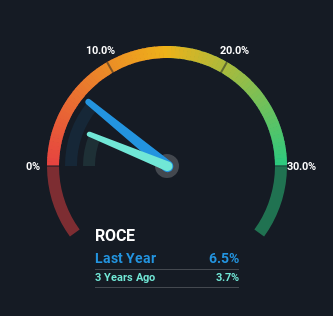- Denmark
- /
- Renewable Energy
- /
- CPSE:ORSTED
Here's What's Concerning About Ørsted's (CPH:ORSTED) Returns On Capital
If we want to find a potential multi-bagger, often there are underlying trends that can provide clues. Ideally, a business will show two trends; firstly a growing return on capital employed (ROCE) and secondly, an increasing amount of capital employed. Basically this means that a company has profitable initiatives that it can continue to reinvest in, which is a trait of a compounding machine. Although, when we looked at Ørsted (CPH:ORSTED), it didn't seem to tick all of these boxes.
Return On Capital Employed (ROCE): What Is It?
If you haven't worked with ROCE before, it measures the 'return' (pre-tax profit) a company generates from capital employed in its business. The formula for this calculation on Ørsted is:
Return on Capital Employed = Earnings Before Interest and Tax (EBIT) ÷ (Total Assets - Current Liabilities)
0.065 = kr.15b ÷ (kr.290b - kr.58b) (Based on the trailing twelve months to September 2024).
Therefore, Ørsted has an ROCE of 6.5%. On its own, that's a low figure but it's around the 6.1% average generated by the Renewable Energy industry.
See our latest analysis for Ørsted

In the above chart we have measured Ørsted's prior ROCE against its prior performance, but the future is arguably more important. If you're interested, you can view the analysts predictions in our free analyst report for Ørsted .
How Are Returns Trending?
On the surface, the trend of ROCE at Ørsted doesn't inspire confidence. To be more specific, ROCE has fallen from 8.6% over the last five years. However it looks like Ørsted might be reinvesting for long term growth because while capital employed has increased, the company's sales haven't changed much in the last 12 months. It may take some time before the company starts to see any change in earnings from these investments.
What We Can Learn From Ørsted's ROCE
To conclude, we've found that Ørsted is reinvesting in the business, but returns have been falling. And investors appear hesitant that the trends will pick up because the stock has fallen 33% in the last five years. Therefore based on the analysis done in this article, we don't think Ørsted has the makings of a multi-bagger.
If you want to continue researching Ørsted, you might be interested to know about the 2 warning signs that our analysis has discovered.
While Ørsted may not currently earn the highest returns, we've compiled a list of companies that currently earn more than 25% return on equity. Check out this free list here.
Valuation is complex, but we're here to simplify it.
Discover if Ørsted might be undervalued or overvalued with our detailed analysis, featuring fair value estimates, potential risks, dividends, insider trades, and its financial condition.
Access Free AnalysisHave feedback on this article? Concerned about the content? Get in touch with us directly. Alternatively, email editorial-team (at) simplywallst.com.
This article by Simply Wall St is general in nature. We provide commentary based on historical data and analyst forecasts only using an unbiased methodology and our articles are not intended to be financial advice. It does not constitute a recommendation to buy or sell any stock, and does not take account of your objectives, or your financial situation. We aim to bring you long-term focused analysis driven by fundamental data. Note that our analysis may not factor in the latest price-sensitive company announcements or qualitative material. Simply Wall St has no position in any stocks mentioned.
About CPSE:ORSTED
Ørsted
Owns, develops, constructs, and operates offshore and onshore wind farms, solar farms, energy storage and renewable hydrogen facilities, and bioenergy plants.
Moderate growth potential with low risk.
Similar Companies
Market Insights
Community Narratives


